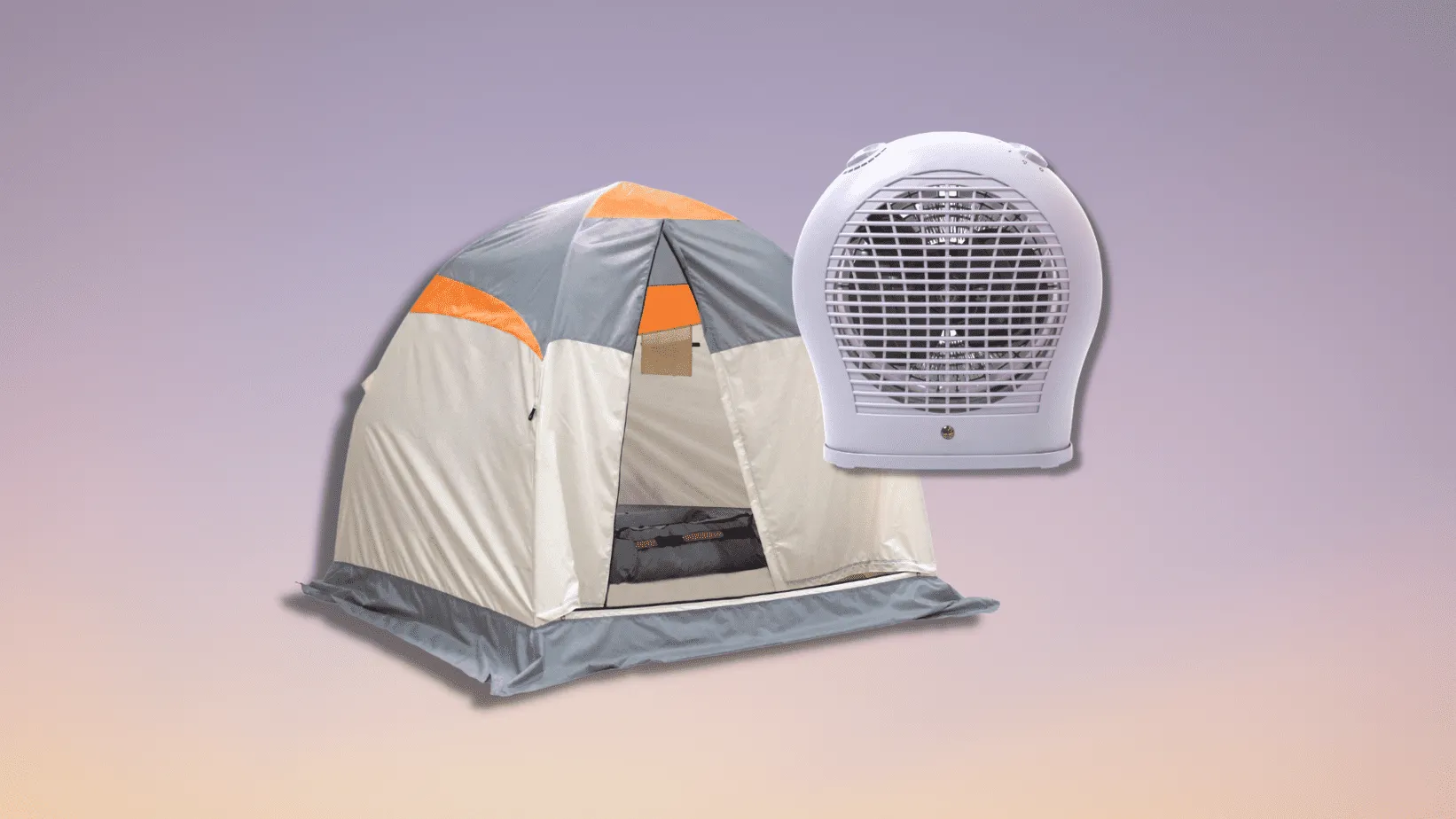According to the National Weather Service, hypothermia may occur when the body drops below 95-degrees Fahrenheit. Needless to say, bad weather that lowers the temperature can put you at risk when you’re camping. That being said, you don’t have to worry as there are plenty of methods to create a warm and safe tent.
Besides making sure you have the proper gear and clothing, you can help warm your tent by adding insulation to the tent’s walls or floor. Another trick is to use rocks, water, or a portable heater to help radiate heat throughout the inside of the tent. Lastly, limiting your tent’s space can help ensure that the heat doesn’t diminish quickly.
If you want a more detailed explanation of how you can keep your tent warm, then keep reading. We will provide you with seven tips and tricks you can use to stay warm on your next outdoor excursion. So, here is how you can keep your tent warm easily.
How to Keep Your Tent Warm
Utilize a Tent Heater
- POWERFUL RADIANT HEAT: This portable gas heater provides cozy, sun-like warmth;...
- IMPROVED SAFETY FEATURES: The propane buddy heater has enhanced the performance...
- RELIABLE IGNITION: Equipped with a durable Piezo igniter; this LP heater offers...
- SIMPLE OPERATION: The propane infrared heater has an easy start knob, fold-down...
- FUEL EFFICIENT: Enjoy 6 hours of warmth on the low 4,000 BTU setting and 3 hours...
A tent heater is a new solution to outdoor camping, as it eliminates the need for thick sleepwear or extra insulation in your tent. A tent heater is a portable electronic device that can help heat small areas such as tents. You won’t need any plug-in source when using a tent heater, as many rely on batteries or propane.
That being said, tent heaters can only help you so much. They are excellent at keeping the inside of your small to medium tent warm. However, a tent warmer may not heat larger tents and shared spaces adequately.
There is also some risk to using a tent heater, which is the risk of a fire. If a tent heater tips over, it has the chance of setting the tent ablaze. So, look for a quality tent heater that includes auto shut-off features.
Insulated Floor Padding
- Pad Length: 48 in / 122 cm (Small), 72 in / 183 cm (Regular), 77 in / 196 cm...
- Pad Width: 20 in / 51 cm (Small and Regular), 25 in / 63 cm (Large)
- Pad Thickness: 0.625 in / 1.5 cm (All sizes)
- Packed Size: 20 x 6.5 / 51 x 17 (Small), 20 x 8 / 51 x 20 (Regular), 25 x 8.5 /...
- Weight: 9 oz / 260 g (Small), 14 oz / 400 g (Regular), 1 lbs 3 oz / 540 g...
While you may not think about it, many tents become colder because the floor isn’t insulated. One solution to keeping your tent warm is to add insulation by using floor pads. Floor pads go directly on the tent’s floor and work by creating a heat reflective barrier that traps body heat and reflects it back into the tent.
Floor padding is ideal when you’re camping in fall or winter. A pad will not only provide you with more heat but will also slightly elevate your tent’s flooring, which keeps you off the direct cold ground. Using a floor pad will make a massive difference in how you feel during the night.
One benefit of using floor padding is that it’s relatively affordable compared to other solutions. It also doesn’t have any risks, unlike heaters, which could catch fire. Aside from that, floor padding provides cushioning, making it more comfortable to walk, relax, and sleep on.
Heat Rocks
Heated rocks are your next best method for keeping the tent warm for extended lengths of time. Although heating rocks take a long time to heat up, they also don’t burn out quickly. Due to this, you’ll be able to keep your tent warm for more extended periods without having to reheat them.
Here is a step by step guide on how you can heat and use your heating rocks:
- Start by creating a campfire in your tent safely.
- Take a few large rocks and place them 5-10 inches away from the fire.
- While the rocks heat up for the next hour and a half, you’ll want to flip them over so that they are heated evenly. However, make sure not to use your hands and to bring tongs to move them around safely.
- Move the heated rocks into different positions around your tent. They will slowly distribute heat for the next few hours.
Using heating rocks can be efficient in small tents, as they radiate small amounts of heat to the surrounding area. However, they do pose a few risks to you and your tent. Make sure to handle the rocks carefully, as they will be extremely hot from the fire. Additionally, you’ll need to remember where you place them, as you don’t want to step on a hot rock.
Insulate Tent Walls
- MANY USES: Can be used as a ground tarp, shelter, tent or emergency blanket when...
- ALL WEATHER BLANKET: This unique blanket features a Mylar reflective side which...
- LIGHTWEIGHT: This blanket weighs less than a pound and will travel lightly in...
- SUPER VERSATILE: Reflects heat, waterproof, windproof, compact, lightweight and...
- 4 REINFORCED TIE-DOWN GROMMETS: Easily hang or secure to reflect or deflect heat...
Adding an extra insulating material to your tent walls can help trap heat inside while keeping wind and cold outside. The key is to use temperature-resistant materials such as silica, high-temperature fiberglass, or calcium silicate fiber. Of course, there are others, but those are just a few.
Hanging a tarp against your tent walls can help you feel warmer. Although, you’ll need to make sure that they sit flush against the tent wall. Secure the materials using velcro, tape, etc. Attaching the materials will enable you to hang them up and take them down when necessary.
The downside to this method is that it’s incredibly time-consuming, and you’ll need to take the insulation down if you start to get warm. This can be a tedious task if you’re only cold during the night. Despite that, we still think it’s worth it if you don’t want to invest in other heating methods.
Ventilate Your Tent
Allowing airflow through your tent in the colder seasons will help keep you warm. This is because when you breathe, water droplets form in the tent and will stick to the fabric. If The temperature is low enough, this can freeze and drop the temperature in your tent further.
If your tent has built-in vents, you may want to open them up partially. Otherwise, open up your tent’s entrance a bit to allow some airflow. The air will enable the tiny droplets to escape and prevent them from lowering the temperature inside your tent.
Use a Smaller Tent
One tip that we have that may seem a bit weird, but we recommend a smaller tent. While a larger tent means more floor space, more room is susceptible to the cold. Reducing your tent size can ensure that the inside of the tent stays warm.
An excellent method to calculate how big of a tent you need is to follow this rule. Per every one person camping, they need at least X amount of space to stay comfortable. Not only will this ensure the tent stays warm, but their body heat will help contribute to the indoor temperature of the tent.
Hot Water Bottles
Besides rocks, you can also use the hot water bottle method. To do this, take a few water bottles and place boiled hot water into them. You don’t want the water to be boiling, but at least warm to the touch.
Fill the water bottles to the brim and close them. Place them around your tent or inside of your sleeping bags. The heat from the water will radiate outwards slowly and will provide some warmth.
The only downside to this method is that you’ll need to have enough empty water bottles with you. Additionally, you’ll also need to have enough water to fill each bottle. Despite that, it’s still an effective and cost-efficient method to keep the inside of your tent warm.
Conclusion
As you can see, there are so many efficient options to keep you warm on your next camping outing (we haven’t even mentioned down blankets for camping). You don’t need to wear layers upon layers of clothes just to feel warm while camping. Instead, use these methods to help create a warm and relaxing environment so that you can make the best of your next outdoor excursion.
If you’re camping when it’s cold, it’s best to bring at least two of these methods as a backup. That being said, it’s not that challenging to keep the tent warmer with just a few adjustments. Hopefully, we’ve answered your question on how do you make a tent warmer?

Alex Mwangi is the creator of Outdoor Right and an outdoor enthusiast. During his free time he enjoys riding his road bike or traveling the world looking for his next adventure.




